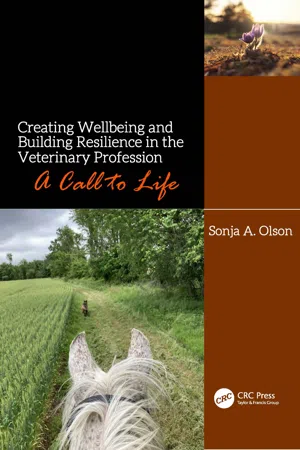
Creating Wellbeing and Building Resilience in the Veterinary Profession
A Call to Life
- 206 pages
- English
- ePUB (mobile friendly)
- Available on iOS & Android
Creating Wellbeing and Building Resilience in the Veterinary Profession
A Call to Life
About This Book
A Call to Life aims to help veterinary caregivers increase self-efficacy, decrease unnecessary suffering, and increase sustainability in their mission to support animal health around the world. The veterinary profession is powered by dedicated, bright, and selfless individuals. Unfortunately, the long-standing and dysfunctional culture in classrooms and practices around the world expects veterinary caregivers to be ready to sacrifice everything – their time, their health, their personal lives – in the name of being deemed qualified and 'worthy.'
Integrating real-life stories from a range of veterinary caregivers with evidence-based theory, practical activities, discussion and reflection points, and insights drawn from the author's own experiences, the book empowers veterinarians by showing that they have the ability and the control to choose a healthier way forward for themselves and for their profession. It describes how to:
-
- Normalize the conversation around mental and emotional health challenges in caregiving environments
-
- Discuss and collaboratively create systemic solutions that promote healthier 'ecosystems' for vets to work within
-
- Develop the skills of reframing, mindfulness, and self-care strategy implementation supporting holistic veterinary well-being
-
- Collectively choose to shift the framework of professional conversations towards psychological safety, optimism, and purpose-driven experiences.
Creating Wellbeing and Building Resilience in the Veterinary Profession: A Call to Life uniquely combines shared experiences (personal stories) with academic research into the contributing factors of compassion fatigue and how to counter these. Normalizing the conversation in the profession, it provides a wide array of possible solutions to build resilience and to shape a culture of collaboration and support where caregivers can flourish.
Frequently asked questions
Information
1 The Evolution of the Veterinary ProfessionHow Did We Get Here?
If you don’t know where you are going, you’ll end up someplace else.—Yogi Berra
Our Shared History
Global Timeline of Veterinary MedicineBC
AD
Modern Day Definition of Veterinary Medicine in Wikipedia (2020):
- Prevention, control, diagnosis, and treatment of disease, disorder, and injury in animals.
- Also deals with animal rearing, husbandry, breeding, and research on nutrition and product development.
- The wide scope of veterinary medicine covers all animal species, both domesticated and wild.
- Veterinary science helps human health through the monitoring and control of zoonotic diseases, food safety, and, indirectly, human applications from basic medical research.
- Veterinary medicine and science also maintain the human food supply through livestock health monitoring and treatment keep pets healthy and long-living.
- Veterinary scientists often collaborate with epidemiologists and other health and natural scientists, e.g., the global One Health initiative—a concept that describes the wellness of humans, animals, and the environment as permanently tied together.1
The Human–Animal Bond of Today
The AVMA recognizes: (1) the existence of the human–animal bond and its importance to client and community health, (2) that the human–animal bond has existed for thousands of years, (3) that the human–animal bond has major significance for veterinary medicine, because, as veterinary medicine serves society, it fulfills both human and animal needs.Note: Human–Animal Bond Certification Program offered through the Human Animal Bond Research Institute (HABRI) and the North American Veterinary Community (NAVC).
Table of contents
- Cover
- Endorsements
- Title
- Copyright
- Dedication
- Contents
- Foreword
- Author
- Illustrator
- Introduction
- Chapter 1 The Evolution of the Veterinary Profession: How Did We Get Here?
- Chapter 2 Caregiver Concerns
- Chapter 3 Being Part of a Compassionate Caregiving Community—for Better or for Worse! Examination of Our Veterinary Professional Challenges
- Chapter 4 Tailoring Your Individual Toolbox for Self-Care and Resilience Development
- Chapter 5 Change Is in the Wind—A New Framework
- Chapter 6 Get Excited and Inspired! The Veterinary Profession of the Future
- Appendix 1: Additional Resources
- Appendix 2: Uncle Mikey’s Maxims
- Recommended Readings
- Facilitator’s Guide
- Acknowledgments
- Index